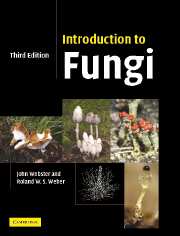Book contents
- Frontmatter
- Contents
- Preface to the first edition
- Preface to the second edition
- Preface to the third edition
- Acknowledgements
- 1 Introduction
- 2 Protozoa: Myxomycota (slime moulds)
- 3 Protozoa: Plasmodiophoromycota
- 4 Straminipila: minor fungal phyla
- 5 Straminipila: Oomycota
- 6 Chytridiomycota
- 7 Zygomycota
- 8 Ascomycota (ascomycetes)
- 9 Archiascomycetes
- 10 Hemiascomycetes
- 11 Plectomycetes
- 12 Hymenoascomycetes: Pyrenomycetes
- 13 Hymenoascomycetes: Erysiphales
- 14 Hymenoascomycetes: Pezizales (operculate discomycetes)
- 15 Hymenoascomycetes: Helotiales (inoperculate discomycetes)
- 16 Lichenized fungi (chiefly Hymenoascomycetes: Lecanorales)
- 17 Loculoascomycetes
- 18 Basidiomycota
- 19 Homobasidiomycetes
- 20 Homobasidiomycetes: gasteromycetes
- 21 Heterobasidiomycetes
- 22 Urediniomycetes: Uredinales (rust fungi)
- 23 Ustilaginomycetes: smut fungi and their allies
- 24 Basidiomycete yeasts
- 25 Anamorphic fungi (nematophagous and aquatic forms)
- References
- Index
- Plate section
12 - Hymenoascomycetes: Pyrenomycetes
- Frontmatter
- Contents
- Preface to the first edition
- Preface to the second edition
- Preface to the third edition
- Acknowledgements
- 1 Introduction
- 2 Protozoa: Myxomycota (slime moulds)
- 3 Protozoa: Plasmodiophoromycota
- 4 Straminipila: minor fungal phyla
- 5 Straminipila: Oomycota
- 6 Chytridiomycota
- 7 Zygomycota
- 8 Ascomycota (ascomycetes)
- 9 Archiascomycetes
- 10 Hemiascomycetes
- 11 Plectomycetes
- 12 Hymenoascomycetes: Pyrenomycetes
- 13 Hymenoascomycetes: Erysiphales
- 14 Hymenoascomycetes: Pezizales (operculate discomycetes)
- 15 Hymenoascomycetes: Helotiales (inoperculate discomycetes)
- 16 Lichenized fungi (chiefly Hymenoascomycetes: Lecanorales)
- 17 Loculoascomycetes
- 18 Basidiomycota
- 19 Homobasidiomycetes
- 20 Homobasidiomycetes: gasteromycetes
- 21 Heterobasidiomycetes
- 22 Urediniomycetes: Uredinales (rust fungi)
- 23 Ustilaginomycetes: smut fungi and their allies
- 24 Basidiomycete yeasts
- 25 Anamorphic fungi (nematophagous and aquatic forms)
- References
- Index
- Plate section
Summary
Introduction
The Pyrenomycetes are defined here according to Samuels and Blackwell (2001) as fungi which produce non-fissitunicate or occasionally prototunicate asci usually in flask-shaped ascomata (perithecia), less frequently in cleistothecia. The sub-class Pyrenomycetes is one of several groups belonging to the huge and heterogeneous class Hymenoascomycetes. The characteristic feature of this class is that the asci develop in an ascohymenial way, i.e. the ascoma is formed after plasmogamy and the pairing of nuclei have occurred, and the asci therefore arise from a hymenium. This is in contrast to asci being formed singly (Archiascomycetes, Hemiascomycetes), scattered throughout the fruit body (Plectomycetes), or formed in a locule within a pre-formed fruit body (Loculoascomycetes). Although the term ‘Pyrenomycetes’ is not generally understood in a taxonomic sense at the present, Samuels and Blackwell (2001) pointed out the monophyly of a core group of orders, including all those which we shall describe in this chapter (summarized in Table 12.1).
The development of the perithecium follows several different schemes defined by Luttrell (1951), which are described in more detail for the different orders. Following fertilization and plasmogamy, the ascogonium gives rise to ascogenous hyphae while the perithecial wall is formed by hyphae arising from the ascogonial stalk or elsewhere. Sterile hyphae growing up from the basal fertile region (paraphyses) and periphyses which line the inner surface of the ostiole, may be present. The development of the opening of the perithecium is typically schizogenous, i.e.
- Type
- Chapter
- Information
- Introduction to Fungi , pp. 315 - 389Publisher: Cambridge University PressPrint publication year: 2007



